How To Draw A Horse Hoof
This post has been originally commissioned for SketchBook Web log in 2016. After the site's migration, the original is no longer available, just y'all tin can withal admission the content hither. Savor!
In SketchBook Original: How to Animate Horses I showed you how to create a horse silhouette with a few simple lines — plus how to create a moving horse out of them. Today, I'll testify you how you can expand your skills to brand that simplified equus caballus wait real. You lot'll learn advanced anatomy, the coat colors, breeds, and a method to depict the hooves and caput. I'll besides show y'all how I drew these horses step by step, along with coloring and shading them in SketchBook.
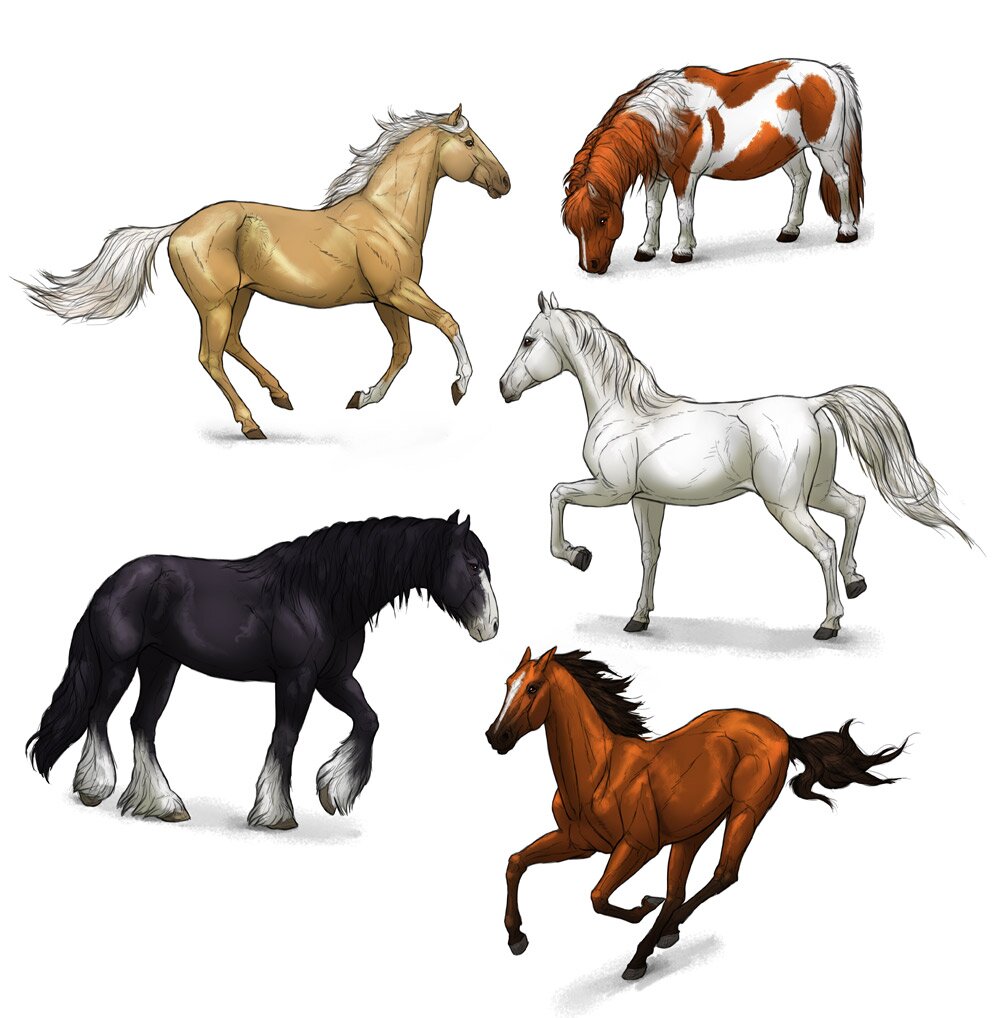
Horse Anatomy
Nosotros learned how to draw the basic anatomy in the last tutorial, now it's time to add together more detail to it. Short hair of the horse makes its muscles very visible, and cartoon a equus caballus without them will make the fauna expect fat. Yous can apply the diagram below to draw realistic muscles, but there's also another fashion.
There's no need to remember all these muscles, because well-nigh of them are not visible virtually of the time. You can use that diagram for a horse in gallop, or for a shiny, muscular horse, but in most cases you only need to remember these forms. They may wait complicated, but give them a attempt and you'll run into how each of them immediately tells you where to put another one.
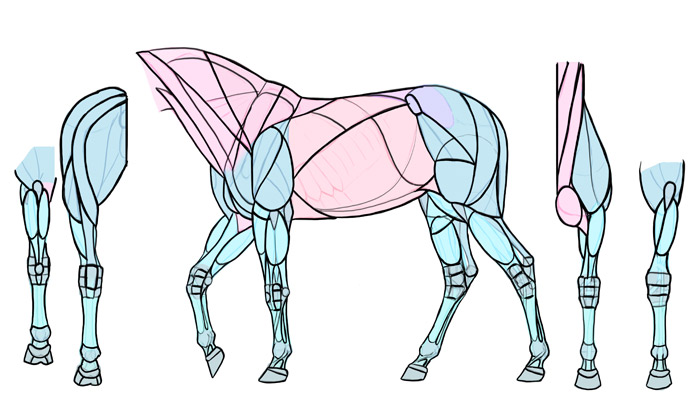
These lines tin be and then turned into a subtle blueprint of fur all over the torso:
To arrive all even more realistic, keep in listen the direction of the pilus over the trunk. Pay special attention to the abrupt modify of direction earlier the thigh and on the chest.
How to Draw Horse Hooves
You already know how to describe unproblematic horse hooves, only let's have a closer look at them this fourth dimension.
Start with a line defining the full general position of the "human foot." Recall about the joints of your finger!

Stop the line with the length of the hoof.
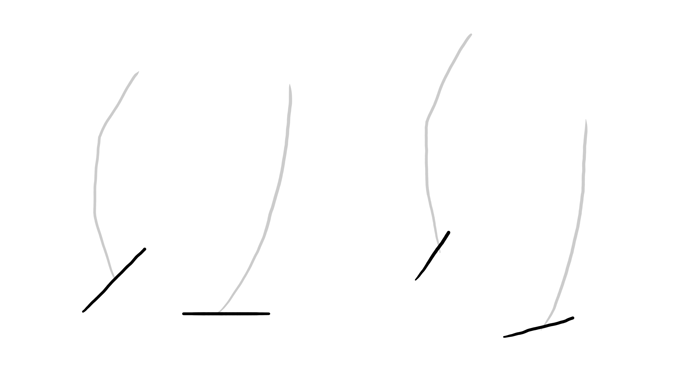
For a 3D position you demand to give the hooves their bodily shape. The lesser of a hoof looks like a cut part of an oval. Ovals, or ellipses, can exist easily drawn in perspective with ane rule: They're sharp next to the astute angles…
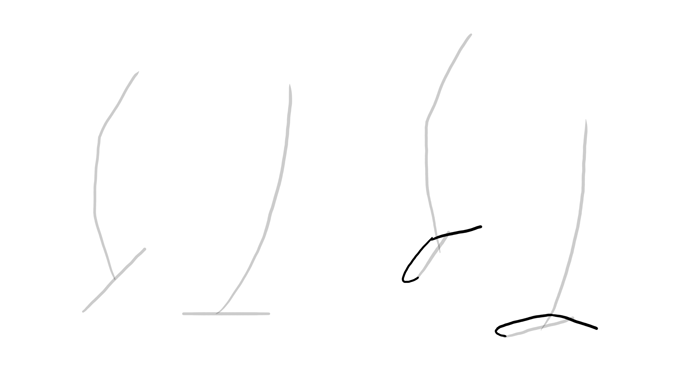
… and flat next to the obtuse angles.
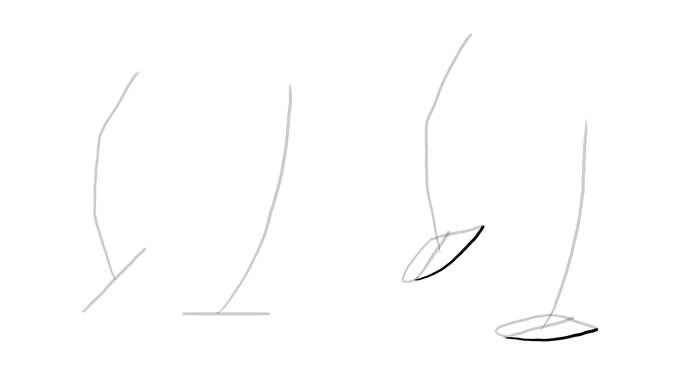
Draw a line above to define the pinnacle of the hoof. Be very careful well-nigh its position in perspective!

Again, add a shape of a role of an ellipse to the top of the hoof. It's slightly rotated, so this can't be just a copy of the bottom.
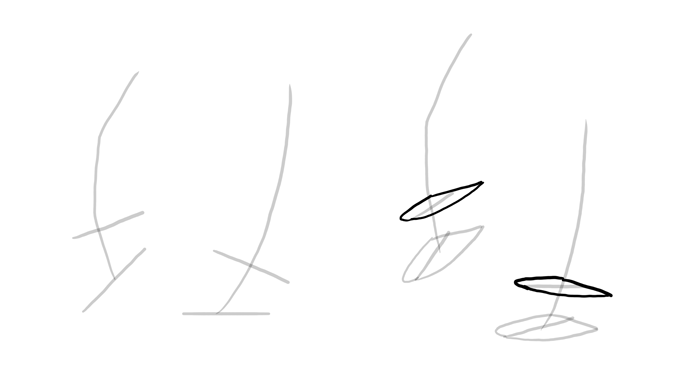
Draw the intersection of the upper part of the "foot." Y'all need to utilize perspective here likewise, merely information technology doesn't demand to be perfect.
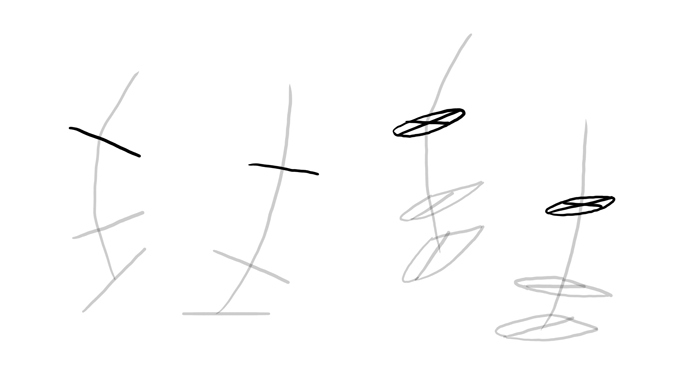
Close the form of the hoof…
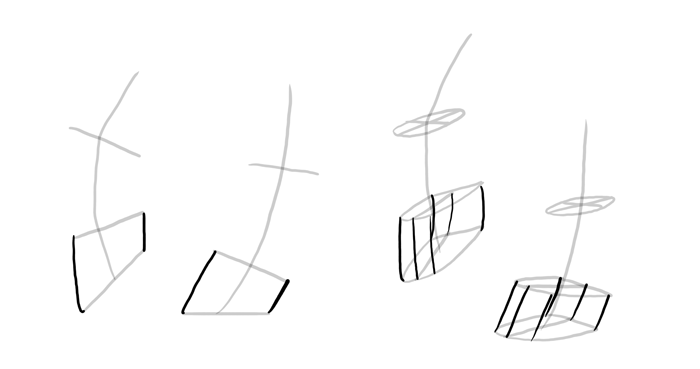
… and of that round part above.
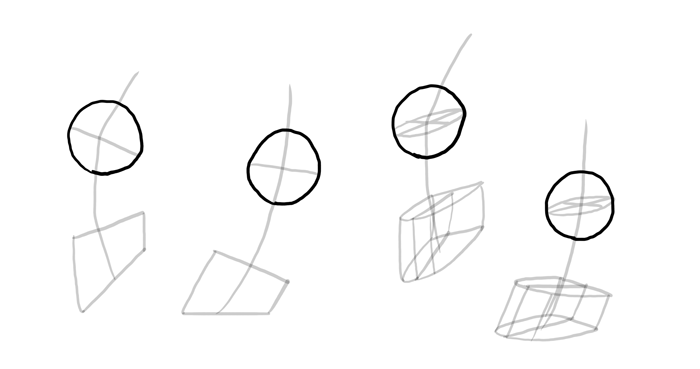
Add the "cap" to the hoof. Observe how it creates two tips backside the hoof—it'south because the hoof is actually a blast with ii edges folded to the back (information technology's non a closed shape).
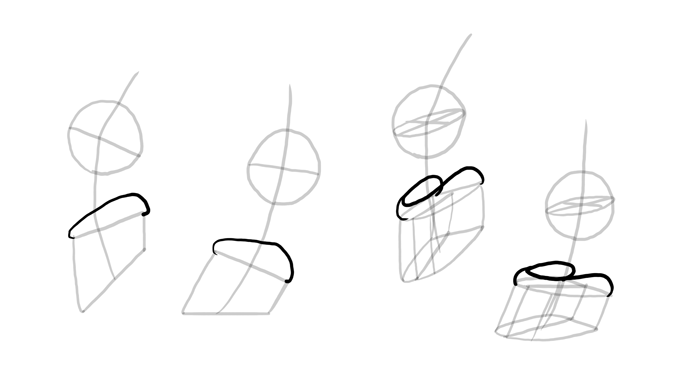
Finish the outline of each pes. In perspective, remember to accentuate the contrast betwixt thin bones and the round parts.
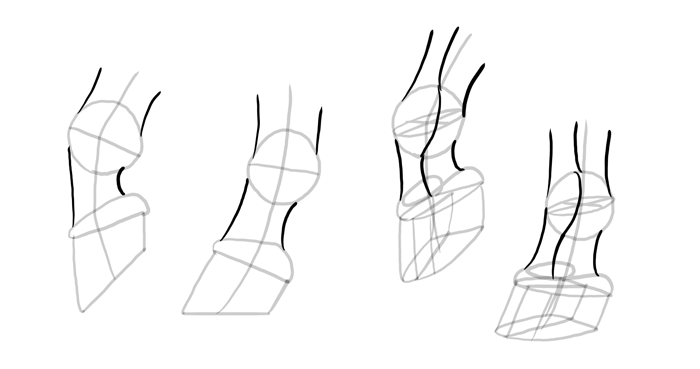
Cease the cartoon. It doesn't need to exist every bit detailed equally this, especially when you're not drawing a shut-up.
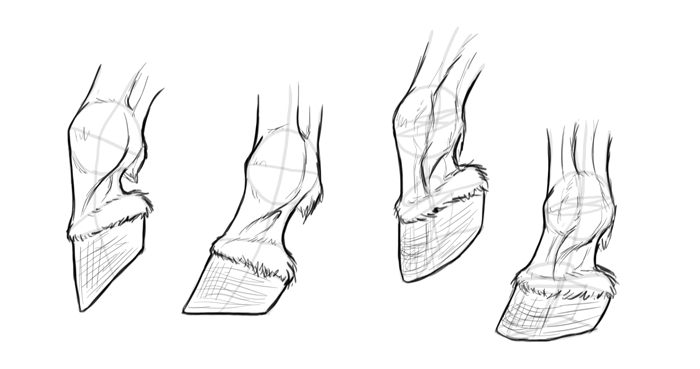
How to Draw a Horse Caput
Starting time with a shape of a flattened teardrop. No matter what perspective yous use for this drawing, yous need to exist able to visualize this form in your caput.
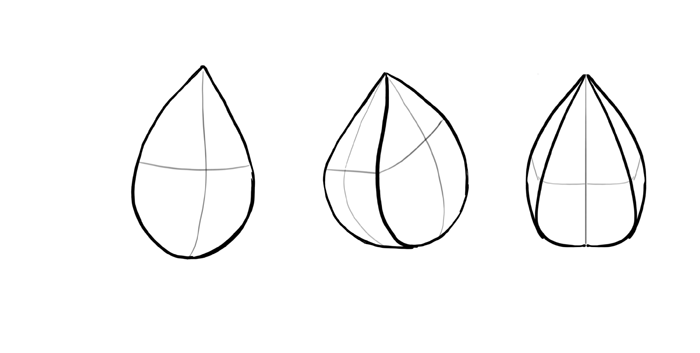
Draw a line to the oral fissure, and end it with a sphere. The space between both forms should be roughly smaller than the sphere.
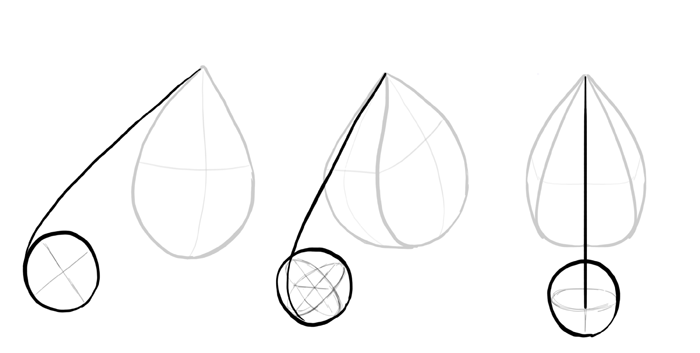
Connect both forms with another line to create the lower part of the head.
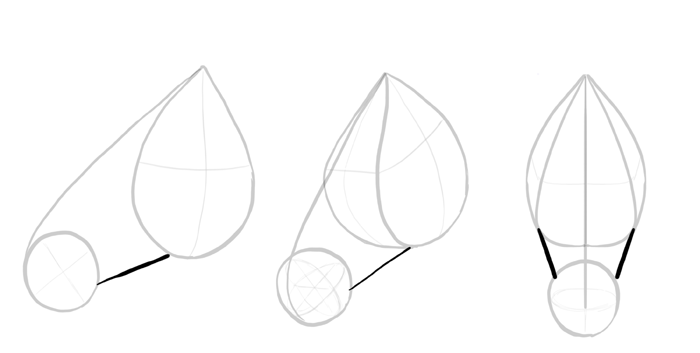
Create the sides of the head with two lines. This side line should be placed roughly in 2-thirds of the head'southward tiptop.
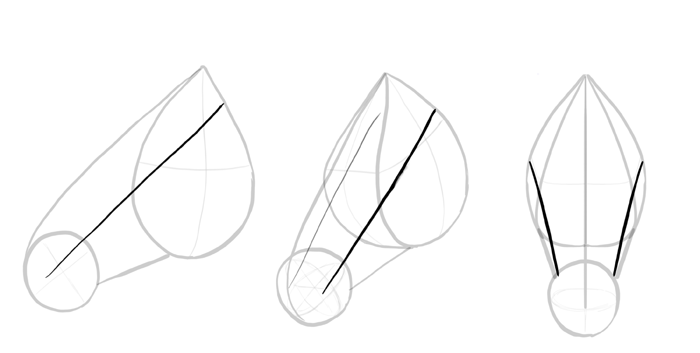
Describe space for the optics and nose over these lines.
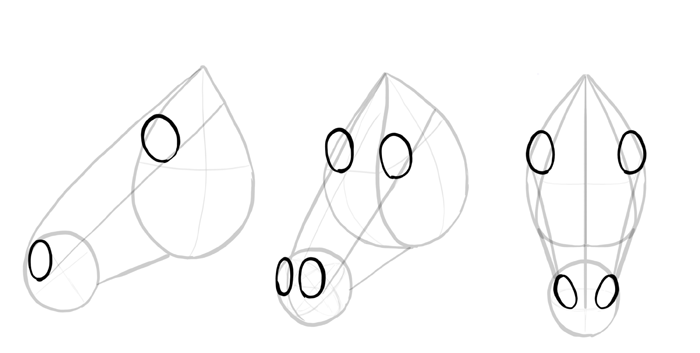
The top of the head is flattened and it has a sure shape. Draw it, connecting optics and nose with it.
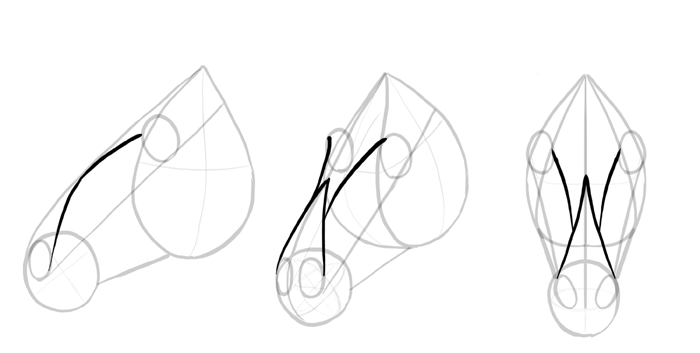
Draw a smaller sphere inside the oral fissure sphere. This will be the space for the actual muzzle.
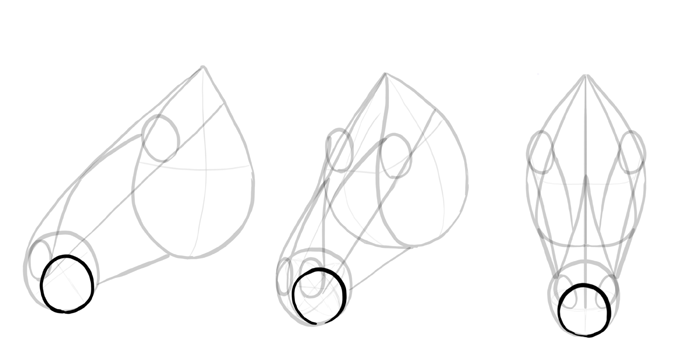
Cutting the sphere in thirds and draw the oral cavity line, finishing it with circular corners.
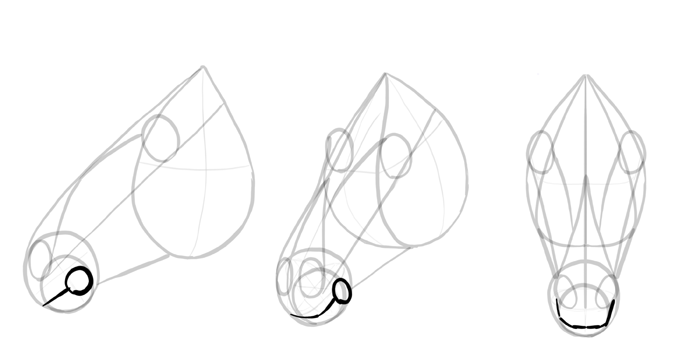
Optics should be slightly protruding, so add together humps behind them.
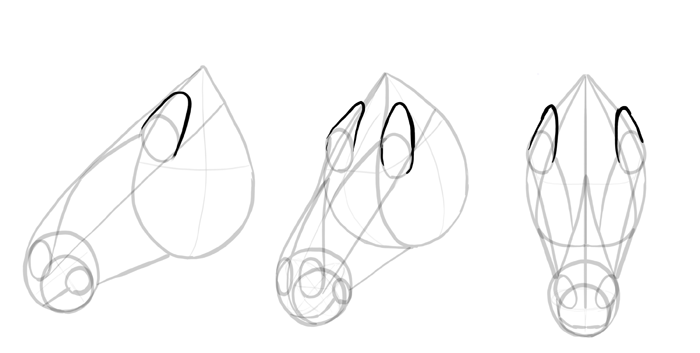
Draw ii spheres on the top of the caput to create the space for ears.

The ears should exist shaped similar narrow ovals stuck to the spheres.
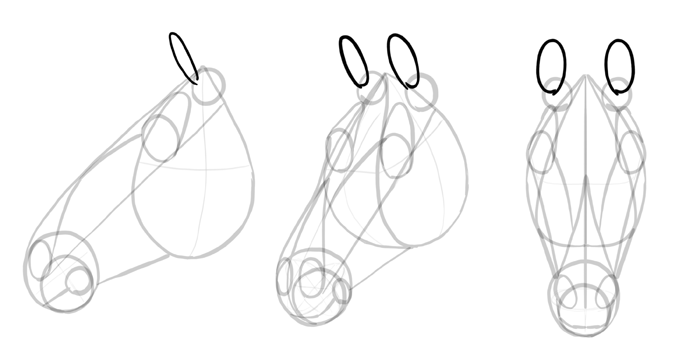
The ears have pointed tips directed towards the middle.
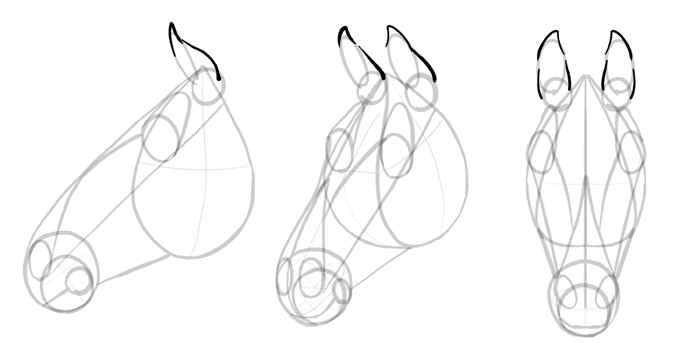
OK, the full general shape of the head is washed! Allow's draw the details now, one by one.
How to Draw Horse Muzzle
Outline the mouth with compact lips. There should be a prominent mentum under them.
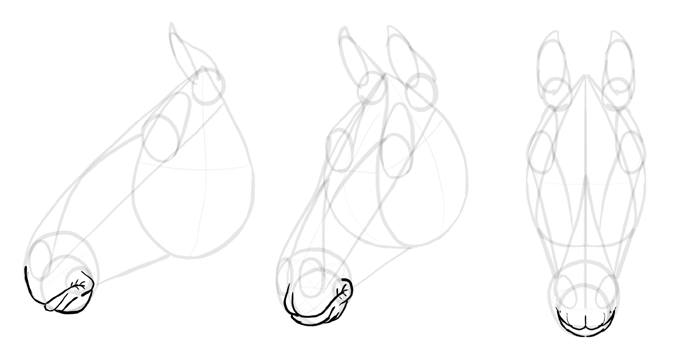
The nose can be drawn with 1 line. This shape tin be narrow when the horse is relaxed, and very round when the equus caballus is running or being angry.
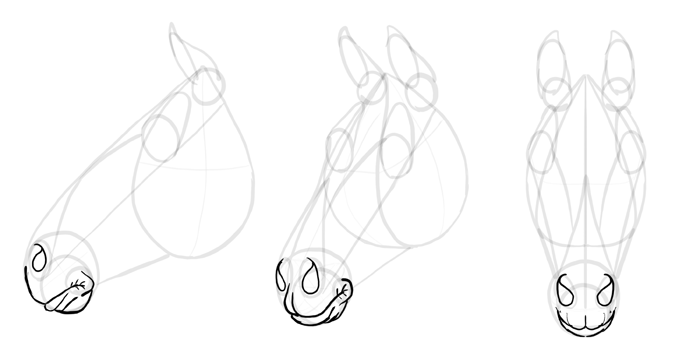
And so y'all can add some fleshy nostrils around.
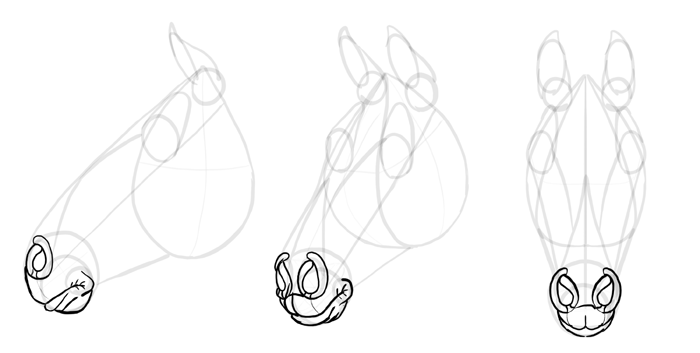
How to Draw Horse Eyes
Start with an oval placed quite close to the brow.
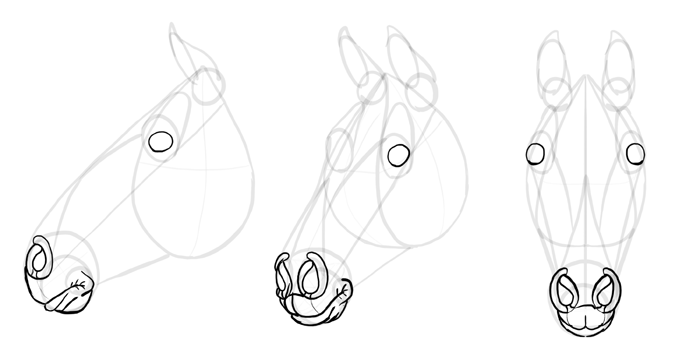
Cover the oval with an eyelid. This shape is very characteristic for a horse.
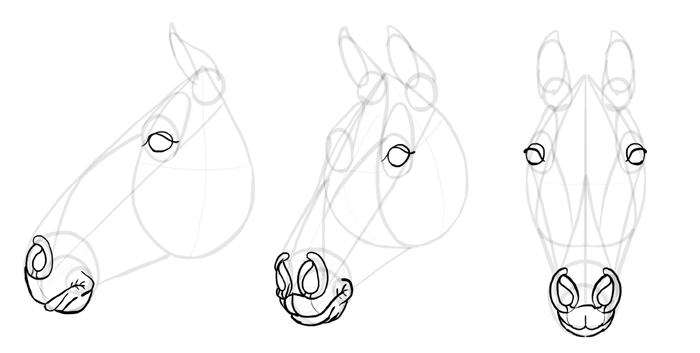
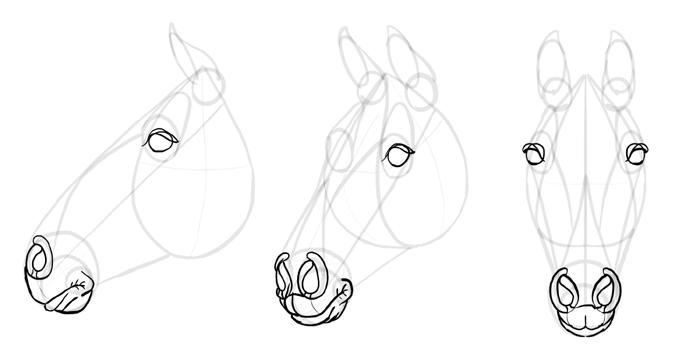
Add the lower eyelid.
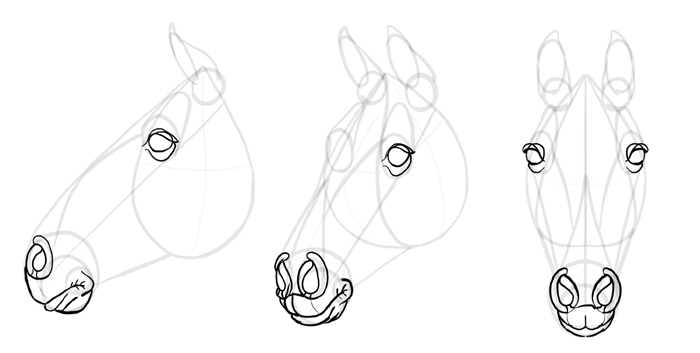
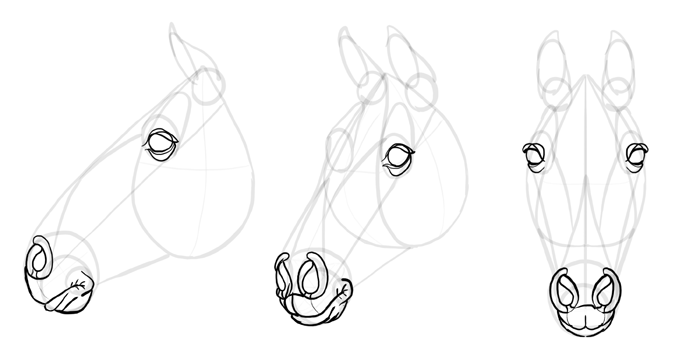
As I mentioned before, the optics are protruding, so add some form above them. It should look like excessive peel folded over the eye.
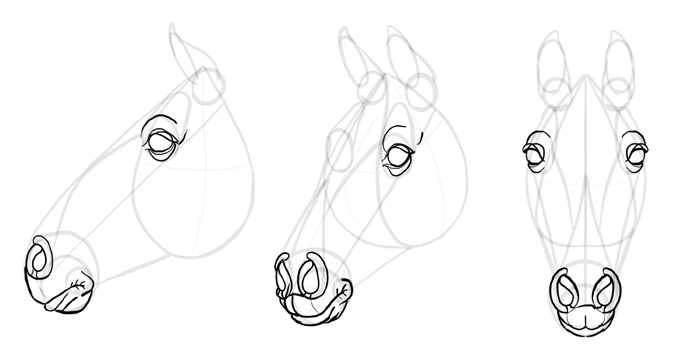
Add the defunction of eyelashes.

Finish past defining bone structure over the eyes.

How to Depict Horse Ears
The ears are made of thin skin, but it nonetheless has some width. Draw the edge of the ears using this width.
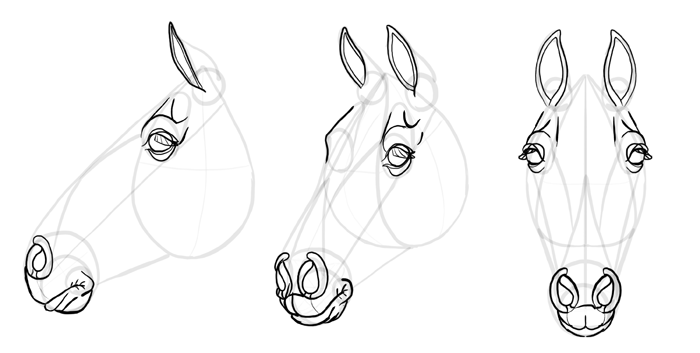
Draw the dorsum of the ears, wrinkling the skin where necessary.
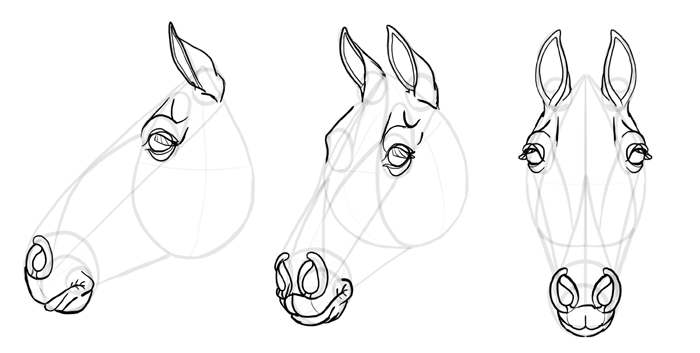
Draw the fur within the ears.

How to Depict Equus caballus Caput Muscles
Y'all can draw a horse head without whatsoever muscles, but they make a cartoon more realistic. Allow's learn how to simulate some beefcake in a simple way.
Outline the cheek. At that place's a bony protrusion on top of it, very important for a realistic look.
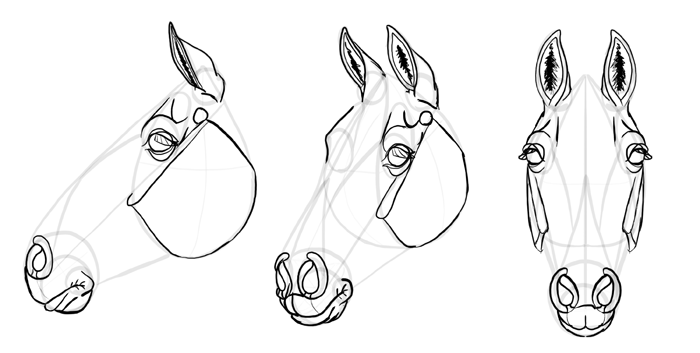
Draw an oval between the cheek and muzzle. It's a complex of various muscles, but it normally looks like one thick muscle and information technology's easier to remember this manner.
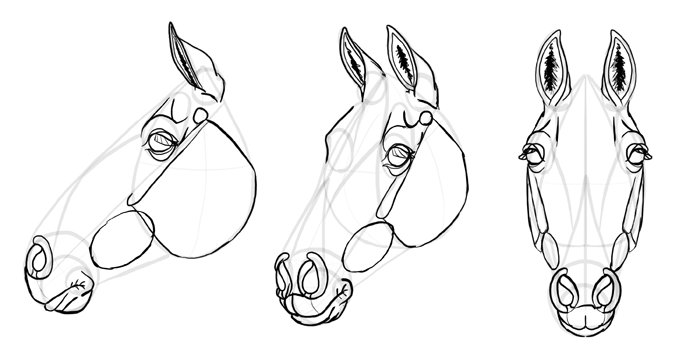
Connect each nostril and the eye with two interconnecting muscles.
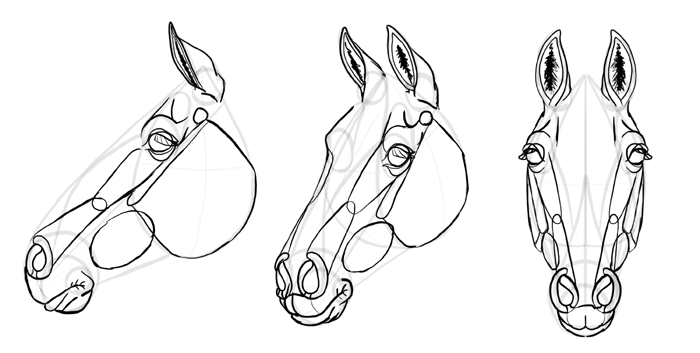
Draw two stretched muscles nether that oval in the middle.
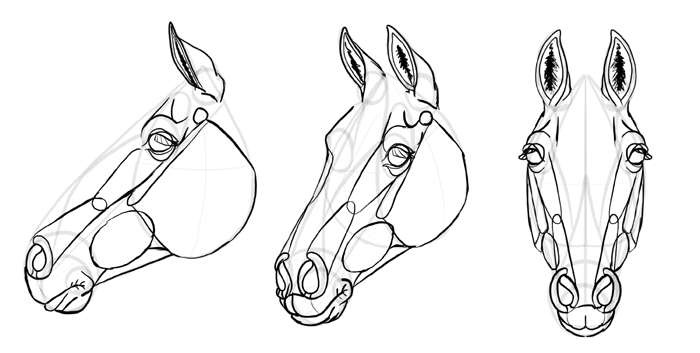
Accentuate the flat brow. At that place's no muscles hither, then its form should be very clear.
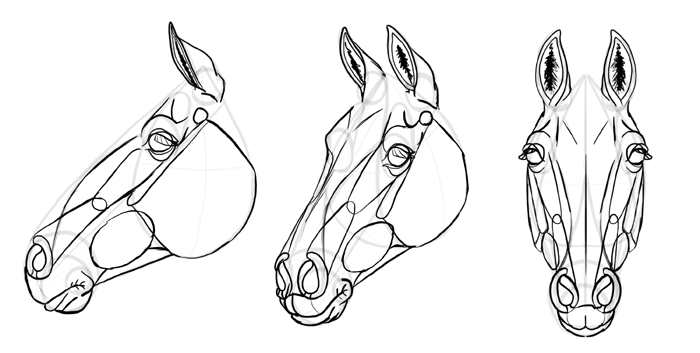
Close the outline of the caput.
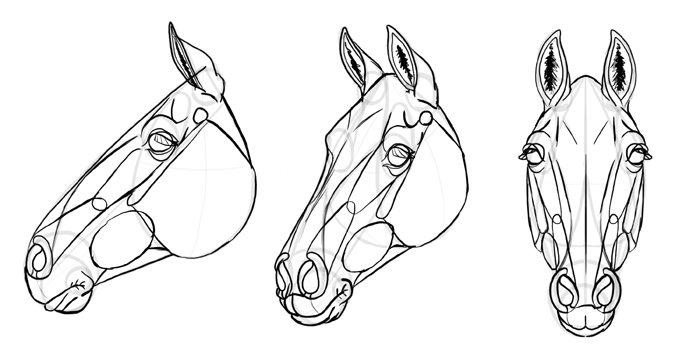
If you lot desire, you can add more details to the muscles this fashion:
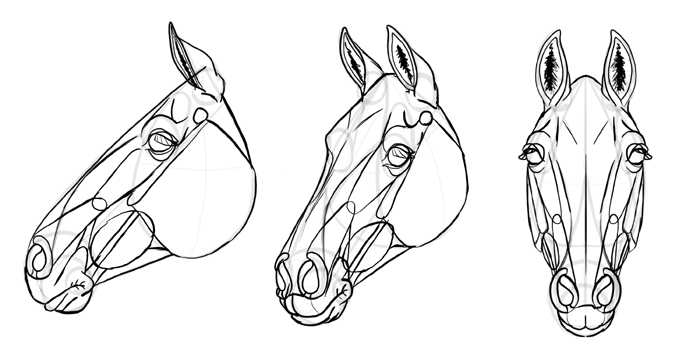
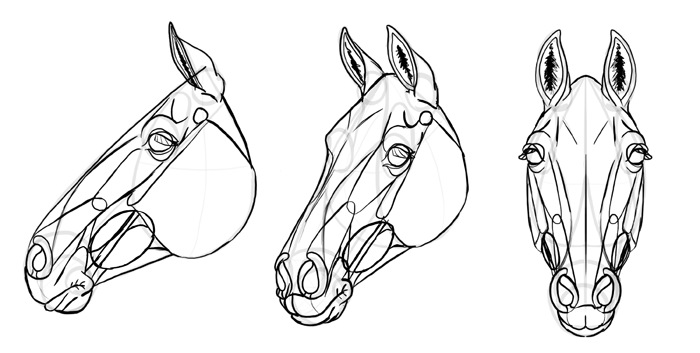
You tin now terminate the drawing! Keep in heed that horses have a horizontal student in their eyes just like goats. In most cases it'due south not visible considering the eyes are brown or blackness, but remember it if you want to give your horse blue eyes!
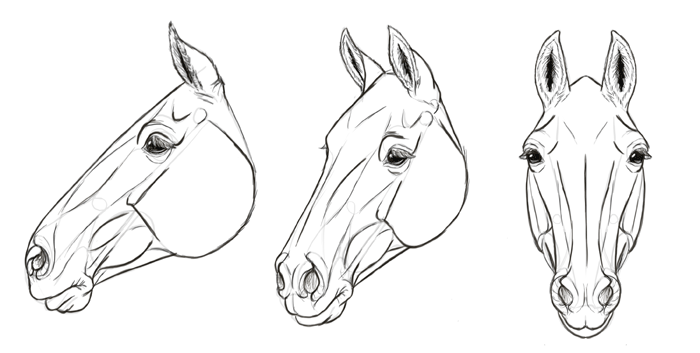
How to Draw a Horse Mane and Tail
Horses are unique non only because of their proportions, only also because of beautiful mane and pilus that's different than hair on the rest of the body. They're not hard to describe, but you need to sympathise how they "piece of work" to create a right drawing.
The bodily tail is quite short and thin, but there'south long hair attached to information technology. It'southward more like a broom of loose hair than a furry tail. The mane grows from the eye of the cervix, and commonly falls on one side of it (or "breaks" to fall to the other side likewise, creating an outcome seen in the first image). Some of the mane hair can country on the brow.
The length of tail and mane in nature is quite set up for practical reasons: the mane covers function or all the cervix, and the tail doesn't come to the ground. However, if the horse is specially cared for, the hair can grow far longer than that.

Equus caballus Colors
Horses take very diverse coloration, with a complex genetic rules backside all the beautiful glaze colors. In theory, there are simply two horse colors: black or not blackness (brown). The other ones are created past boosted genes that strengthen, weaken, or mix the actual base colors. You don't need to go a specialist of genetics to depict a realistic horse; just use this chart for the most popular combinations (I'chiliad pitiful if I didn't include your favorite one—there's also many!). If yous want to know more (or remember it better) I'll tell you a few words well-nigh each color:
- Chestnut: a base color, also called red. Chestnut horses accept even color over the body, with the mane and tail either the same color or brighter (chestnut horses with very brilliant mane band tail are called flaxen). The bodily color tin vary from brilliant red to very nighttime brown (east.g., liver anecdote).
- Bay: a very popular colour for most breeds. Information technology looks like chestnut with black "points:" lower legs and mane with tail. Bay horses tin have various shades of brownish, with a special variation chosen seal-dark-brown bay. Such a horse sports a very dark shade of brownish, with red showing under the belly, before the thigh, behind the elbow, and on the muzzle.
- Grey: Gray horses are frequently confused with white. They are built-in with another colour, and then they gray out with age. Since they proceed a nighttime pare from their previous glaze, they're never fully white (they often accept a darker muzzle and fur around the optics, unless their original coat had white markings in those places). Grayness horses may expect quite differently during their transition into a fully "white" stage. We differentiate, among others, rose gray (a ruby-red/brown horse lighted by white hair), flea-bitten grey (almost completely white pilus with unmarried carmine hairs all effectually the trunk; it can be the last stage as well), and dapple gray (various shades of gray with spots of white).
- White: It'due south a rare color, and it happens simply if the skin is pink (without pigment). Truly white horses are built-in white, and they can have blue eyes. White horses are non albino!
- Palomino: It's a lightened version of chestnut. Palomino horses are gilded/blond with mane and tail of the same color, brighter, or even white.
- Buckskin: Just like palomino, but it happens to genetically bay horses. The main coat becomes lighter, while the points stay night.
- Cremello: It'due south a whitened version of palomino (just even so not truly white). Cremello horses often take blueish eyes.
- Roan: Roan horses accept a "normal" color mixed with white pilus on the main trunk. Nosotros differentiate strawberry roan (chestnut), bay roan (bay), and blueish roan (black).
- Blackness: Different from night bay, information technology'south ordinarily tinted with blue or reddish (if bleached by dominicus). Blackness horses are frequently born as mousy-gray.
- Dun: It's idea to be a colour of the original wild horses, as Przewalski's horses are all dun. Dun horses are tan or mousy-grey (grulla/bluish dun), and all of them have a night stripe coming along their back. They can as well show primitive markings: dark stripes on the legs and shoulders. The mane and tail can exist frosted with white hair.
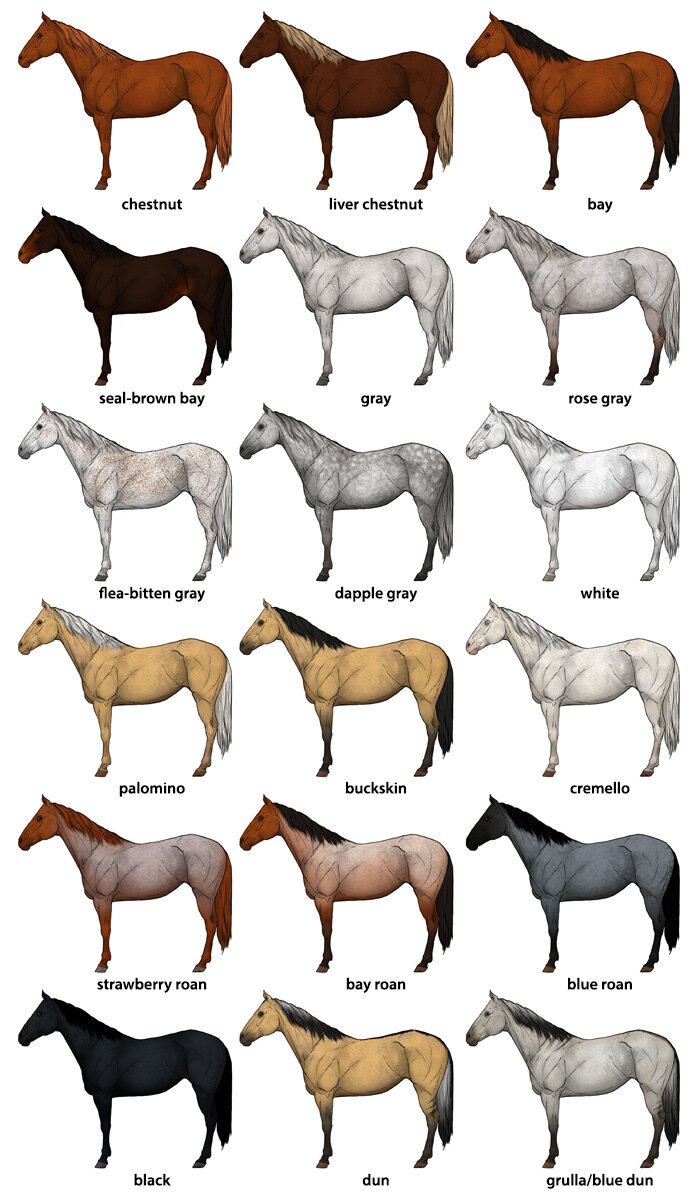
Horses can too have colors combined in a special pattern. Tobiano horses with black base of operations are called piebald, and the others—skewbald.
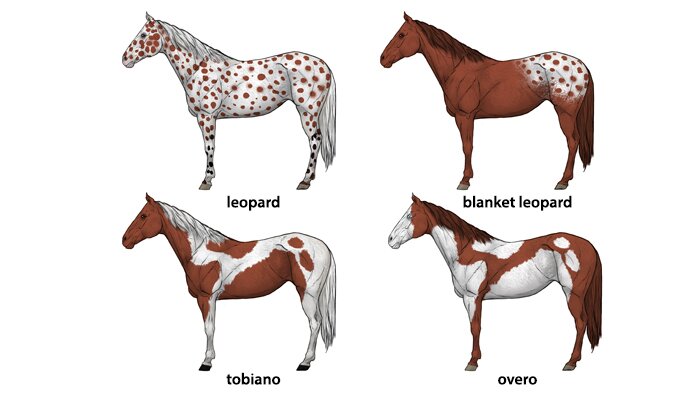
Of class, regardless of the color combination, horses tin can also have white markings on the trunk that make them look unique. The skin under them is usually pink.

How to Draw Horse Breeds
I've shown you how to depict a "general horse," simply horses come in many shapes. Let's learn how to modify that full general recipe to create a few different types of a horse. Keep in listen that my diagrams are slightly exaggerated to accentuate the differences betwixt breeds. You need to written report the breed using photos, videos, and real horses if you desire to create a perfect image.
Quarter Horse
This is "typical horse" number 1. Harmoniously built and visibly strong; this is a horse yous would imagine working on a farm or carrying a knight to war. Quarter horses come in nearly all available colors.
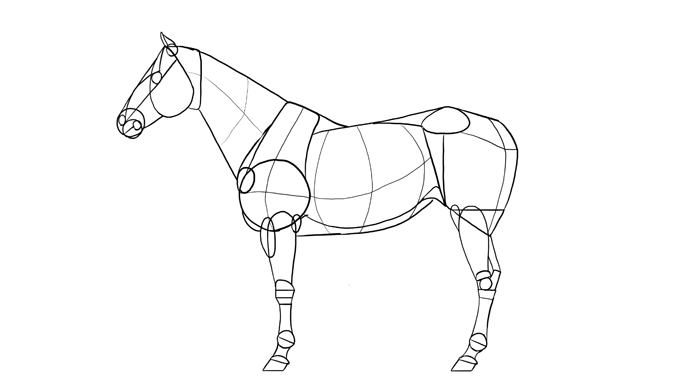
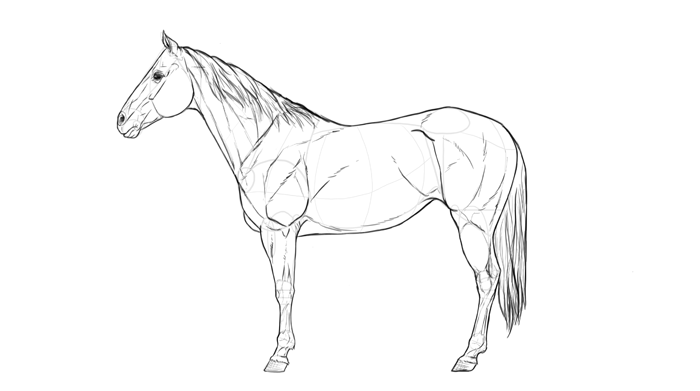
Thoroughbred Horse
This is "typical equus caballus" number two. Y'all can imagine it equally a quarter horse modified for racing—its silhouette is slimmer, with longer legs and sharper muzzle. Thoroughbred horses are usually anecdote, bay, blackness, or gray (roan and palomino can occur besides).
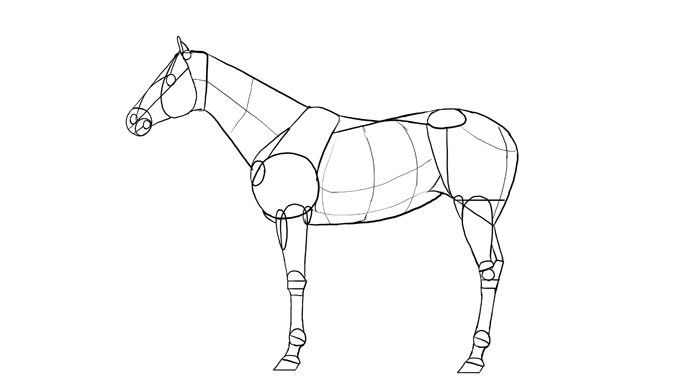
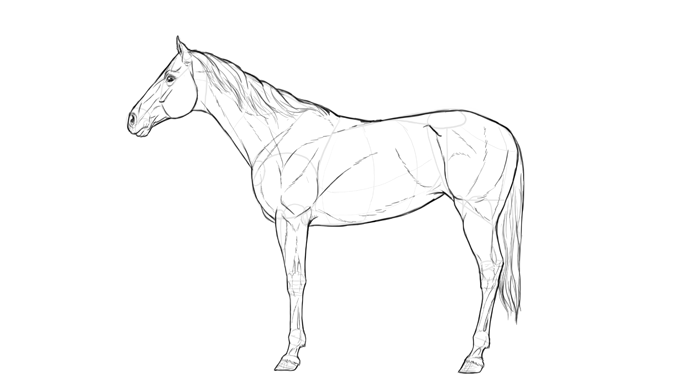
Arabian Equus caballus
These beautiful horses wait like an even slimmer, more elegant version of a thoroughbred horse. They have a characteristic round brow and large optics, and keep their tail high, even when relaxed. This makes the rump expect flatter than in other horses. The neck is biconvex, though it's not visible in every pose. Arabian horses tin be grey, bay, chestnut, roan, or blackness.
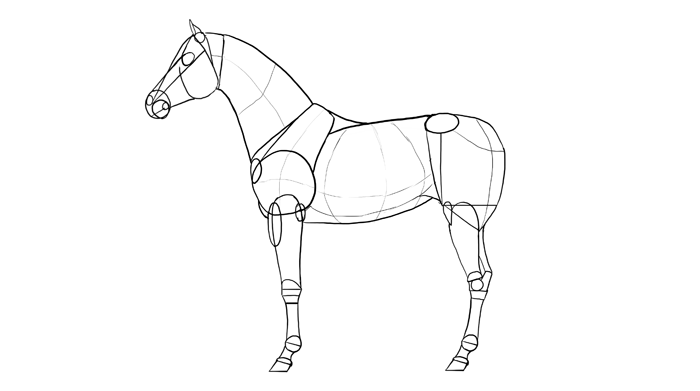
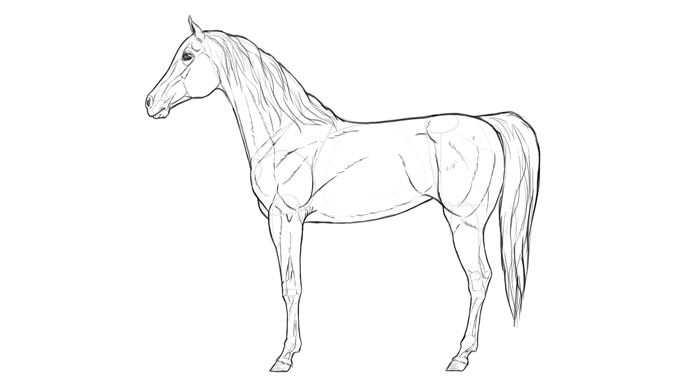
Shire Horse
Shire horses are draft horses, which ways they're bred for heavy work on the farm. They're very strong, which shows through their silhouette. They're large and heavy, so the hooves are noticeably larger and flatter than in other breeds. The head is huge, with the optics looking small in comparison. Shire horses come in many colors, unremarkably bay, chestnut, grayness, black, or roan.
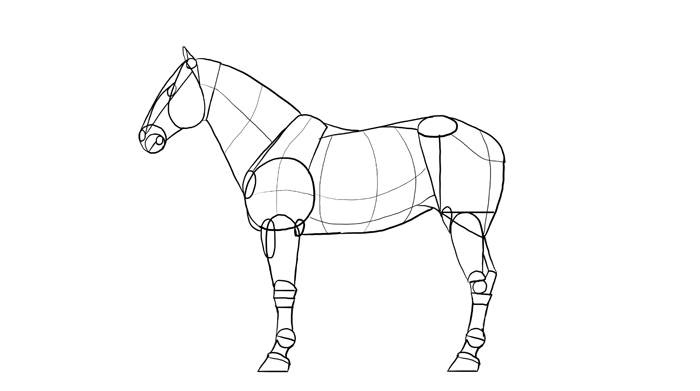
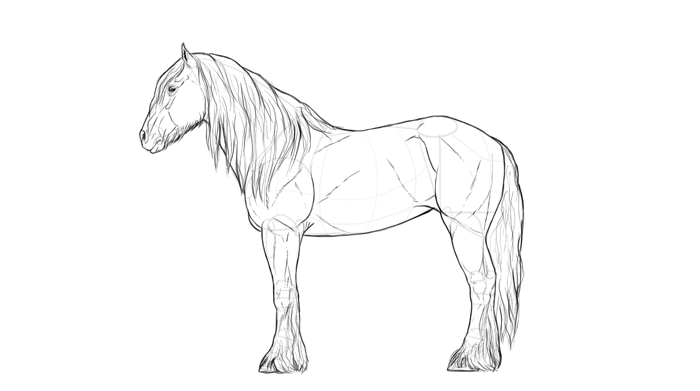
Shetland Pony
Ponies are horses too, just with quite different proportions. Well-nigh pony breeds have a proportionate body with shorter legs, but Shetland ponies take this characteristic to extreme: their legs are oftentimes shorter than their trunk. If you lot comprehend the legs, you'll meet other subtle differences you need to pay attention to. Shetland horses come in all the colors, just are usually chestnut, bay, gray, black, dun, or roan.


How to Draw a Horse Step by Pace
This was then much data! Permit's use it now in do. You lot can draw from imagination, but it's better if you use a few references and draw them footstep by step. This style you'll empathise the process faster. Don't copy me—analyze what I'g doing and why I'm doing information technology instead.
Offset with the principal body. It'southward fairly similar in all the breeds, so yous don't have to use whatsoever special measurements here.
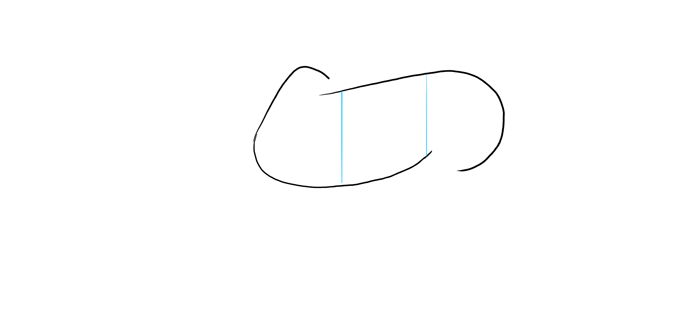
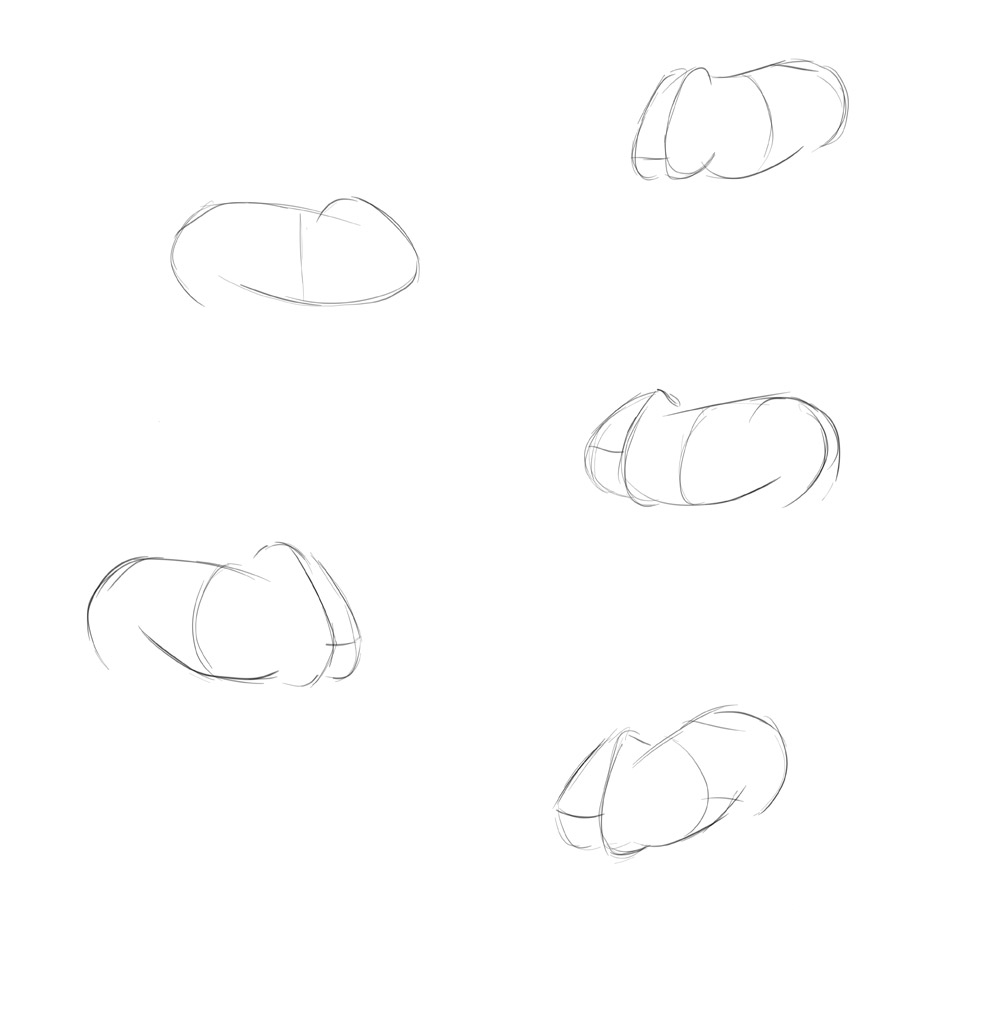
At present add the neck and head. This is the part where the proportions thing a lot. Roughly, the head should be as long as the shoulders, and neck shouldn't be much longer than that. Even so, this proportion is not then clear and it'due south adept to practise it from references to grasp it.
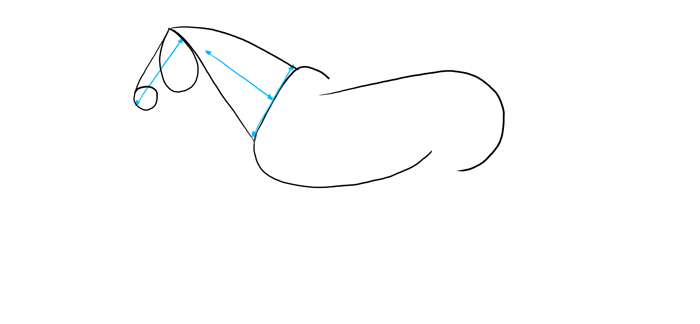
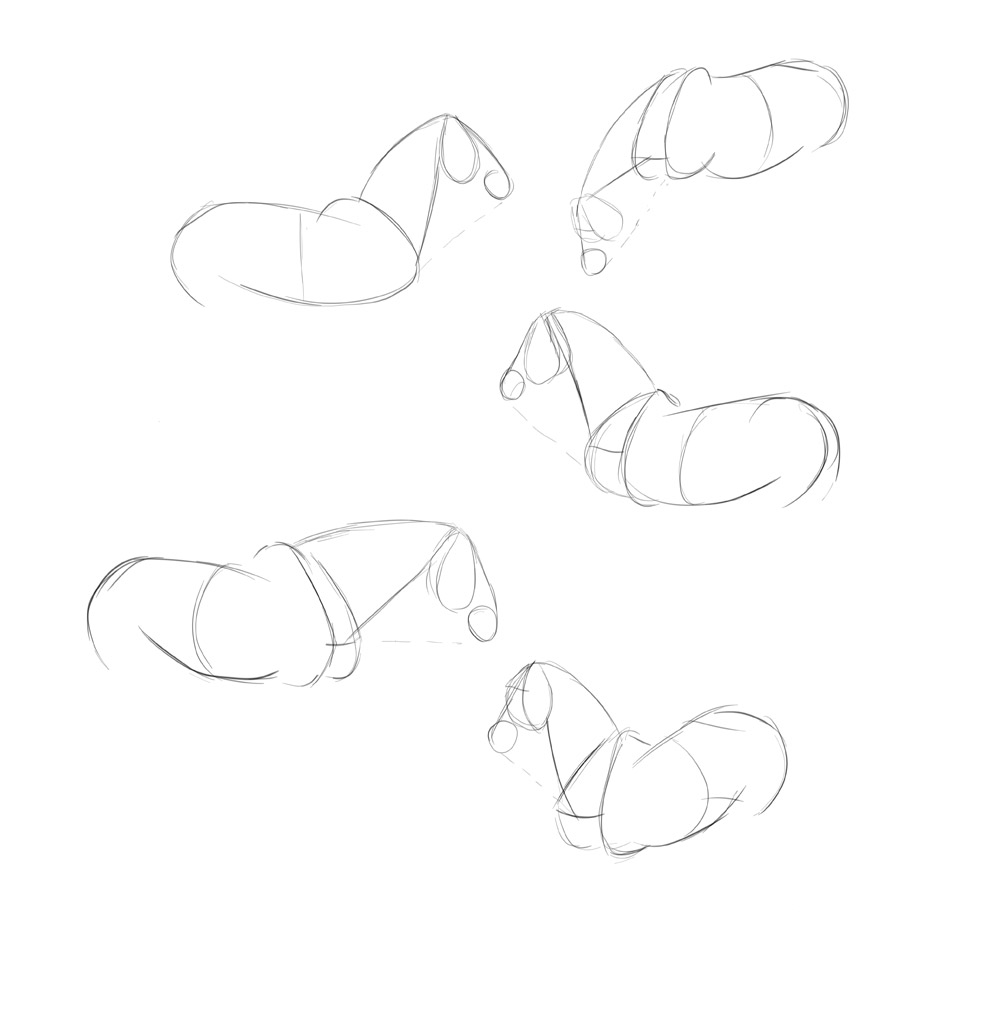
Time to find the terminal proportion: the distance to the ground. Information technology depends on the breed, only in well-nigh cases this distance is equal to the top of the main body plus some more distance for the hooves.
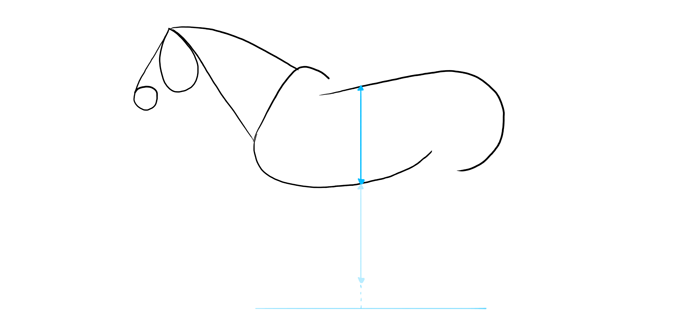
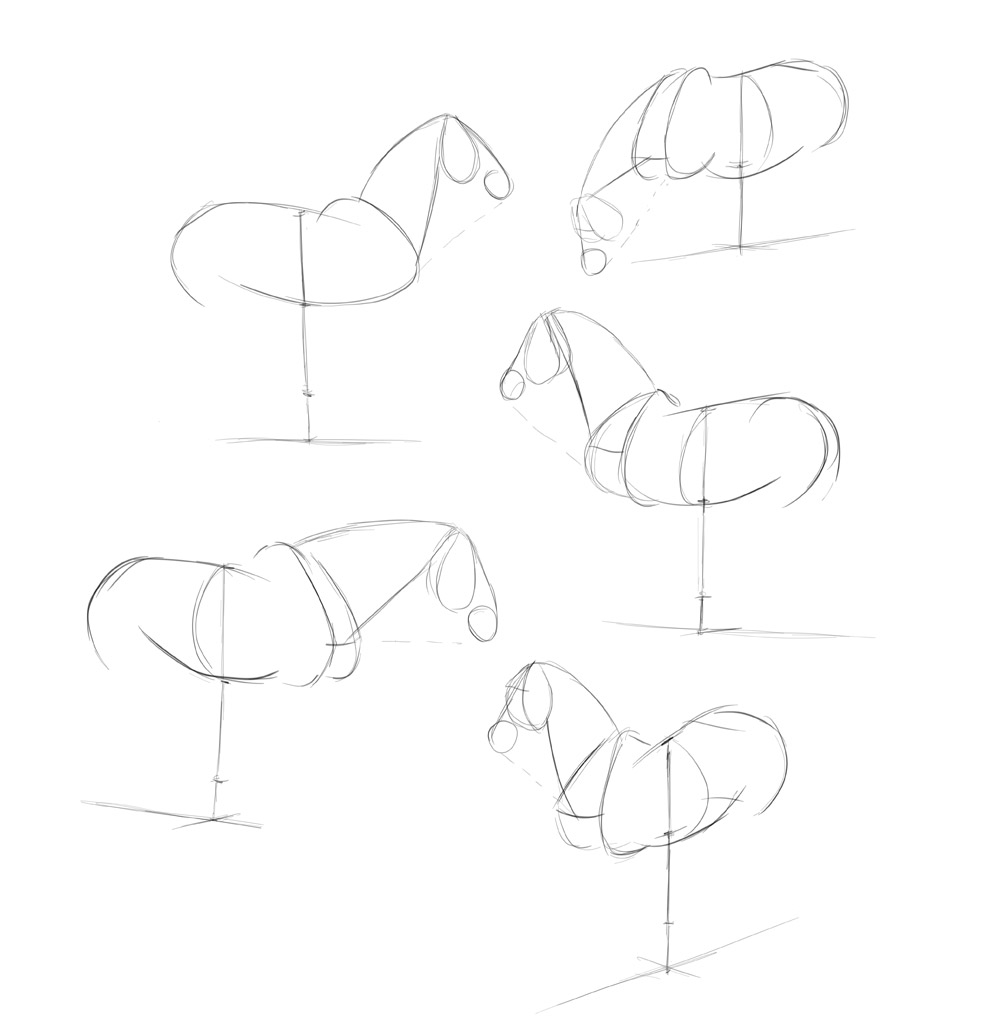
Permit's add the legs now. You lot should exist able to imagine the default position of them, with all the hooves on the basis. And then you can find a correct position for the joints in move using this default position equally a reference.

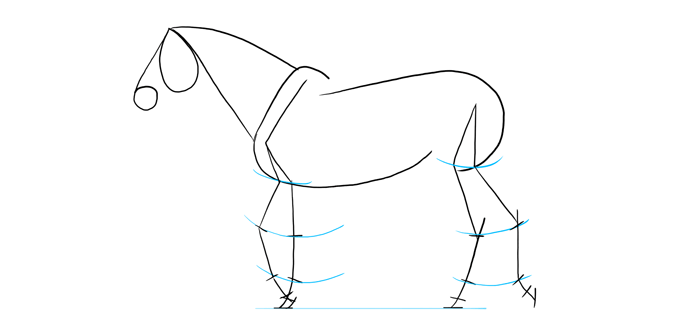
Beginning with simple lines for the legs…
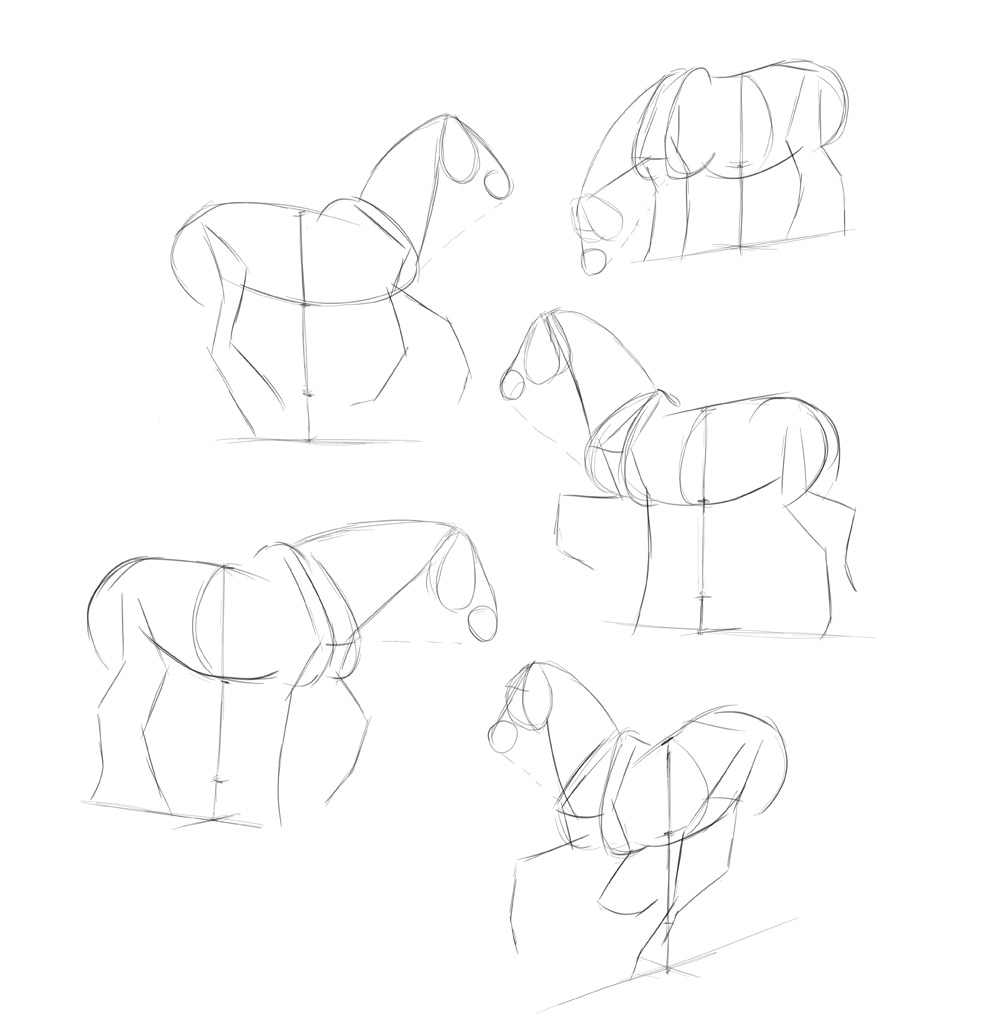
… then add together the lines for the joints. Detect how you can rapidly depict the hooves in perspective without measuring anything.
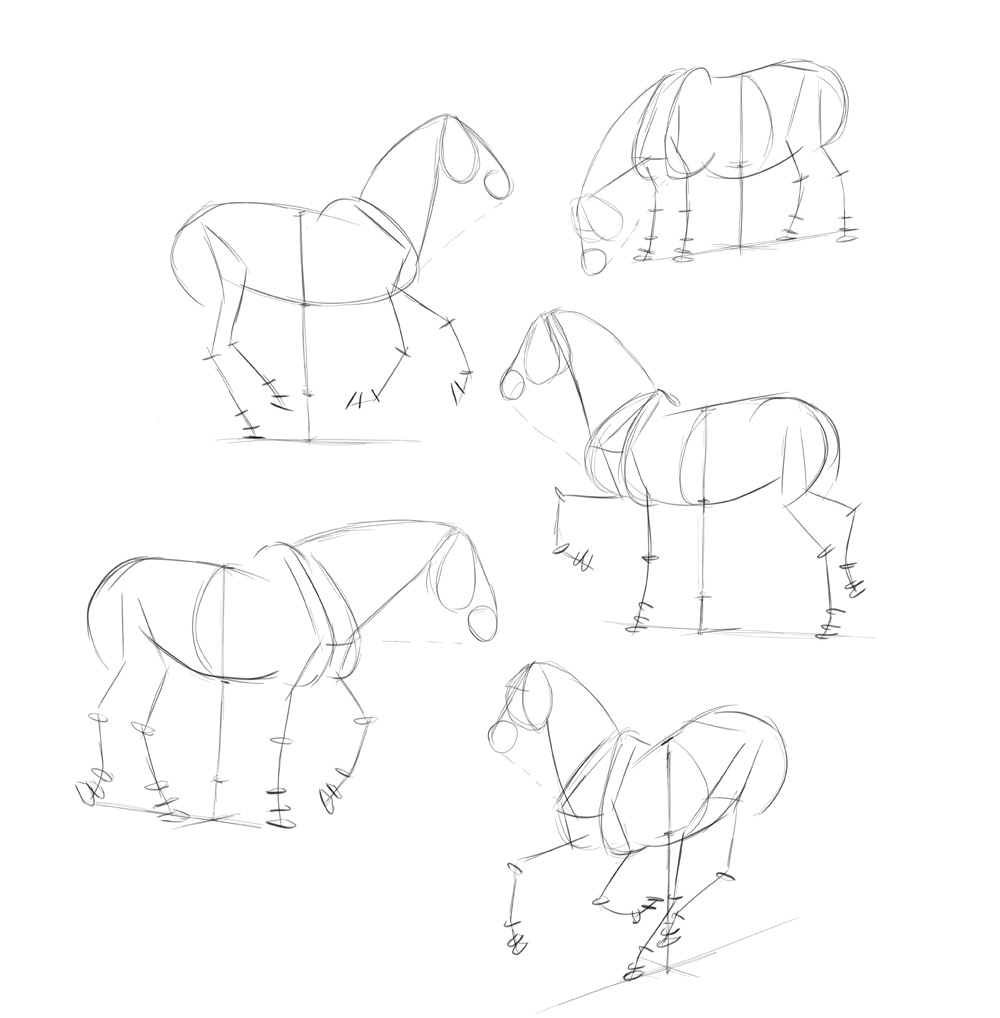
If your horse looks correct in this simplified form, you tin can now build on it, adding more elements. Kickoff yous can add width to the legs by sketching the shape of the joints.

And then yous can add together all the simple forms in the equus caballus's trunk.
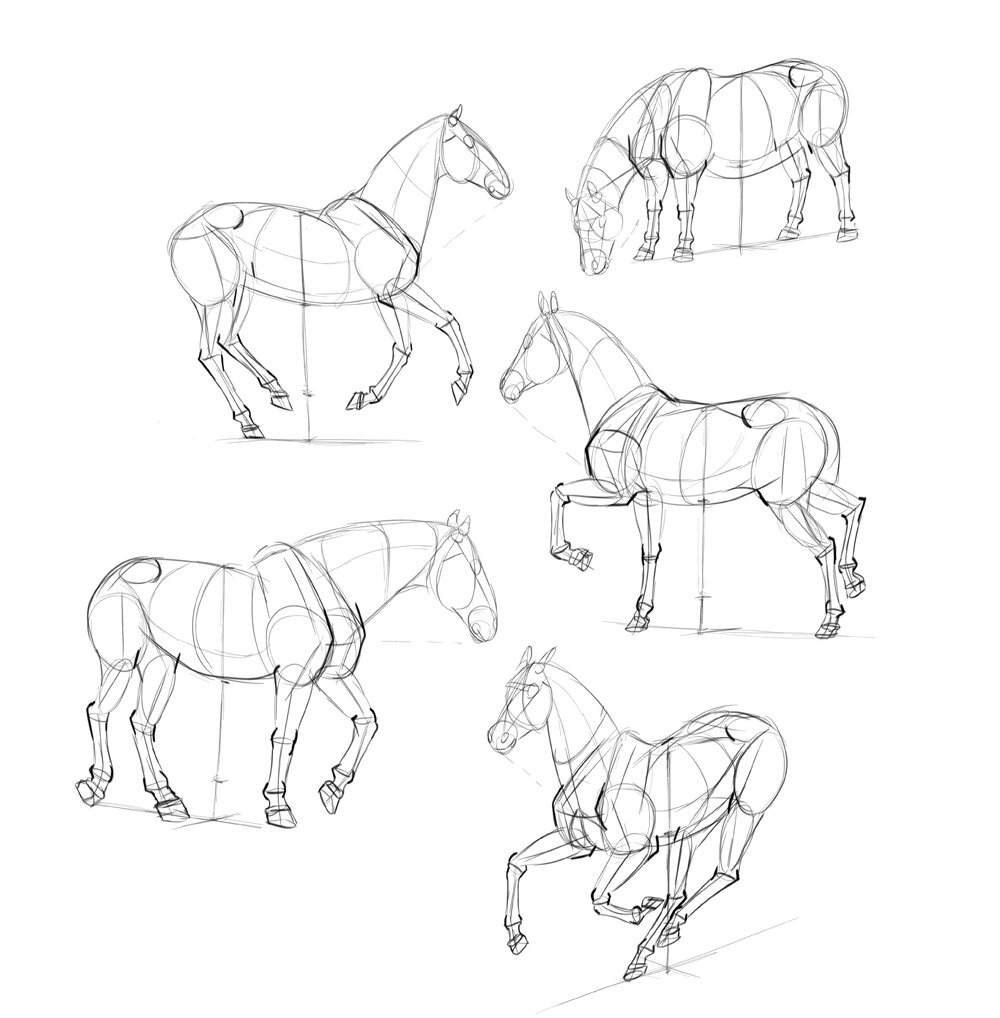
Once the body is properly constructed, you can add the details: muscles, facial features, and mane with tail.
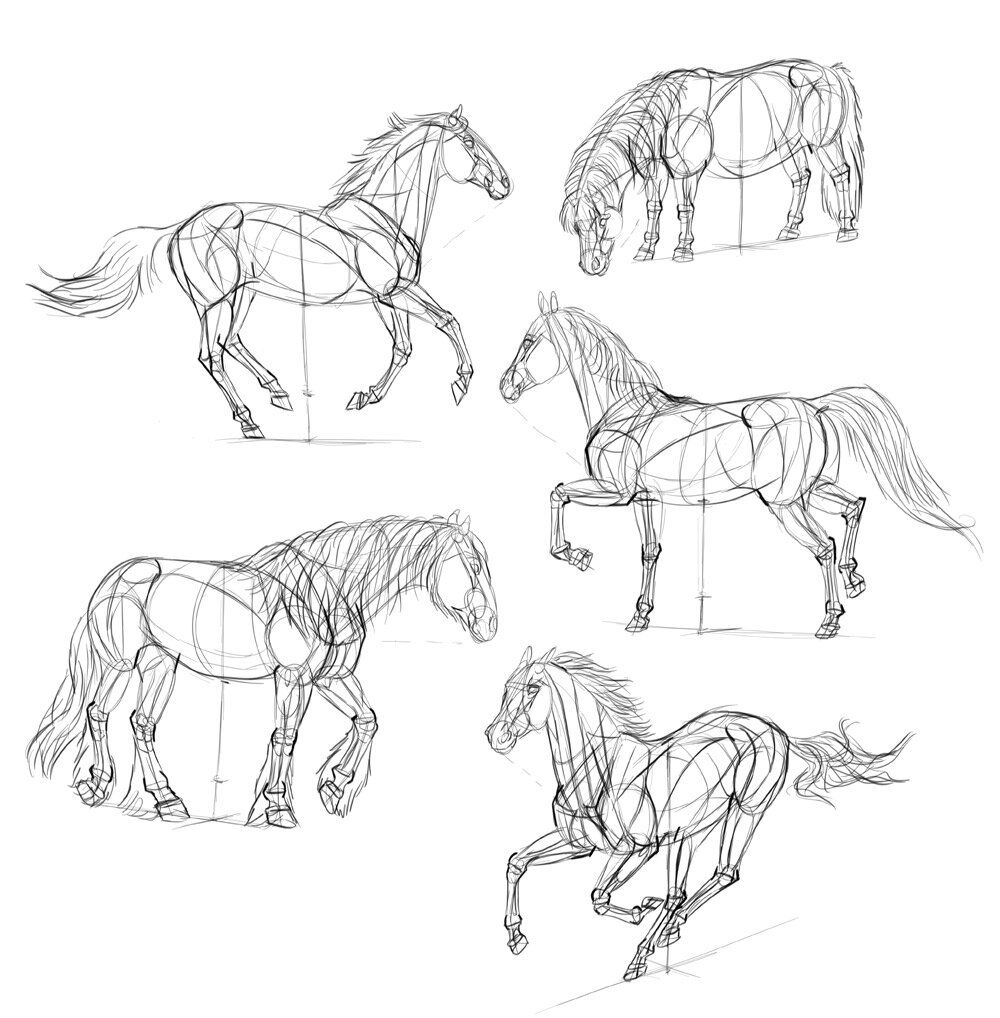
The sketch is done! Now y'all can create the bodily drawing using it as a base.
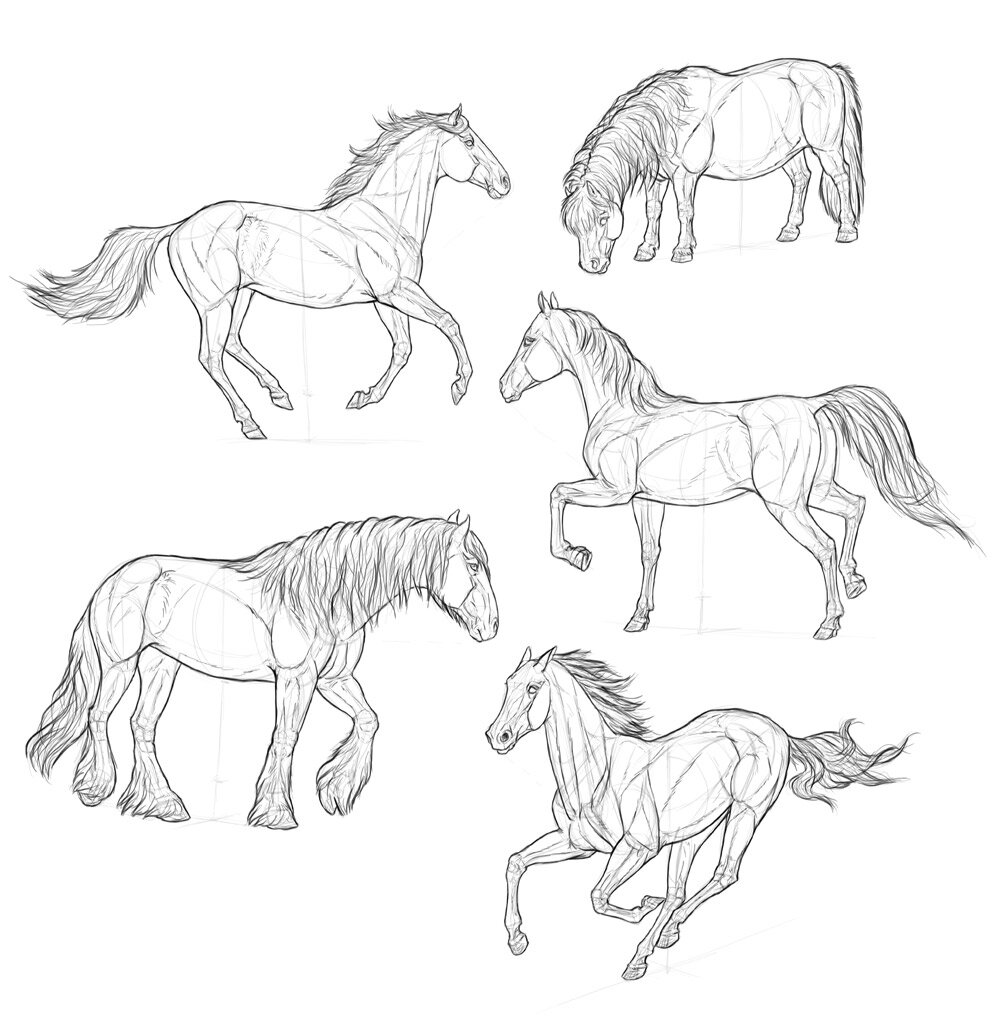
Fourth dimension for the virtually fun part. Color your equus caballus using the diagram with popular coats, or create your ain fantastic color combination.
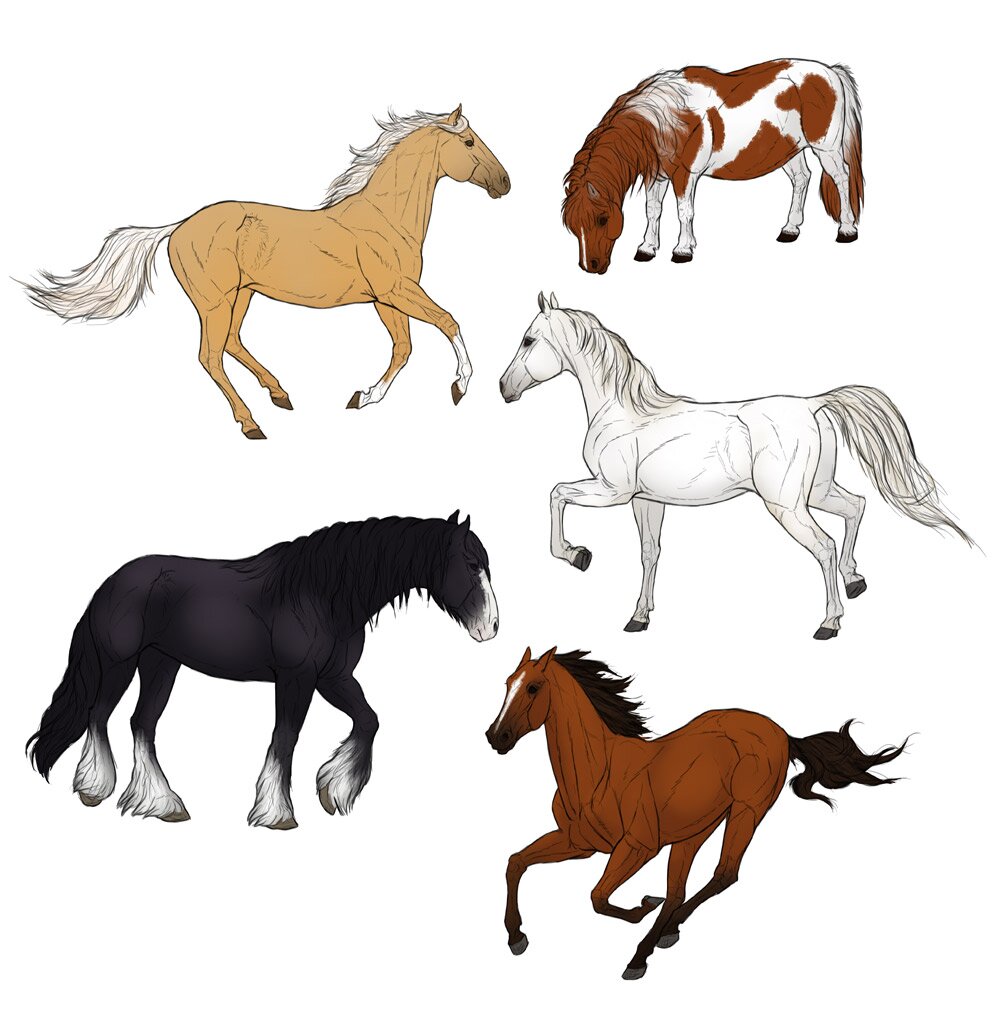
You can shade the horse to accentuate the 3D form of its trunk. Use this image as a reference, but adjust information technology to your own lighting conditions.

In SketchBook yous can pigment the shading on a split layer…
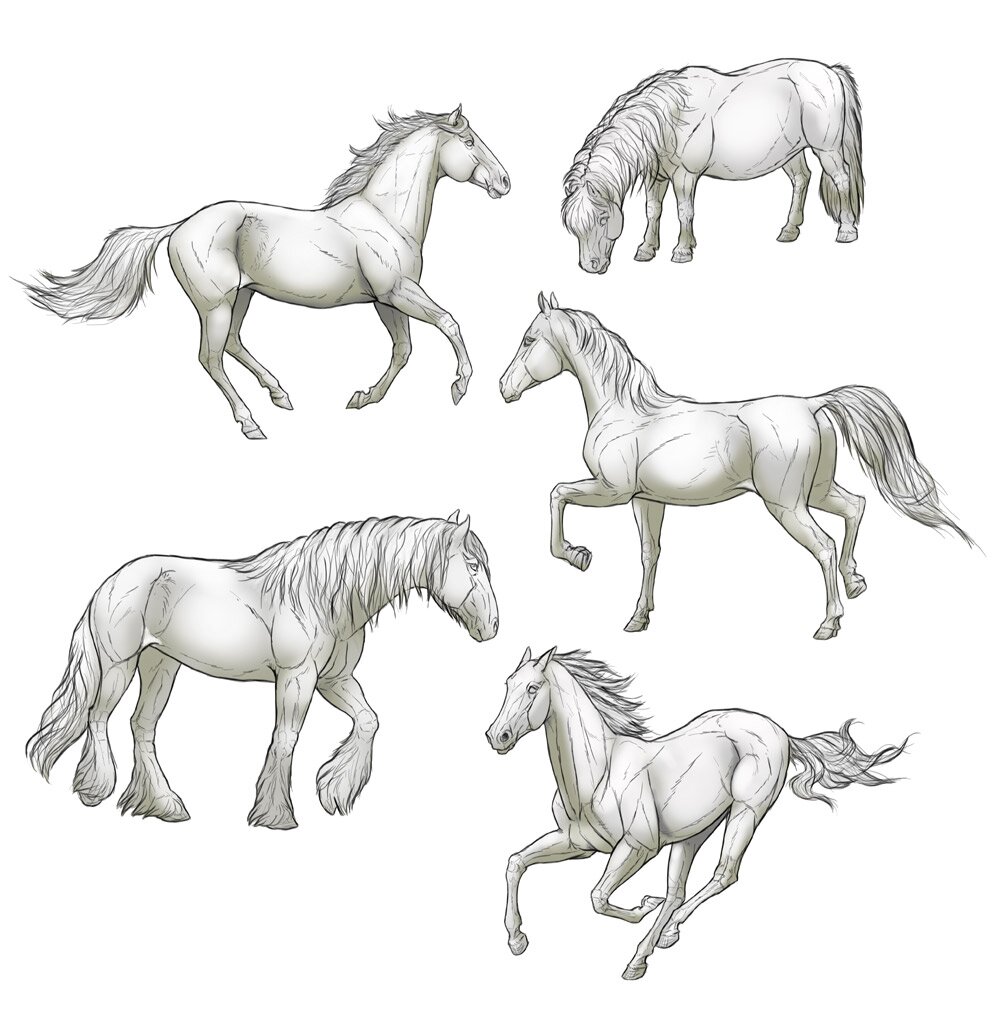
… and and then change its mode to Multiply to affect the colors underneath.

Finally, you tin can make the equus caballus hair shiny to make its form fifty-fifty clearer. Keep in mind this is stylization—horses are not and so shiny in nature, especially when they're covered with warm fur.
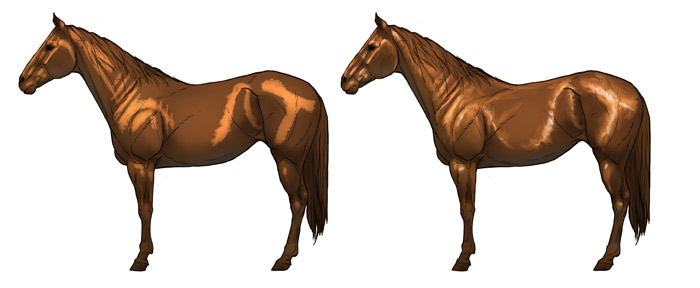

That'due south All!
But your job is not done! To describe horses from imagination you lot demand to understand the rhythm of their body and make it intuitive for you. In order to do information technology you need to draw a lot of horses: from photos, videos, and life. Use this tutorial as a set of tools to depict rapidly and purposefully, only learn from real horses to translate my simplifications to the real life.
Source: https://monikazagrobelna.com/2019/09/15/sketchbook-original-how-to-draw-horses/
Posted by: davisbantais.blogspot.com

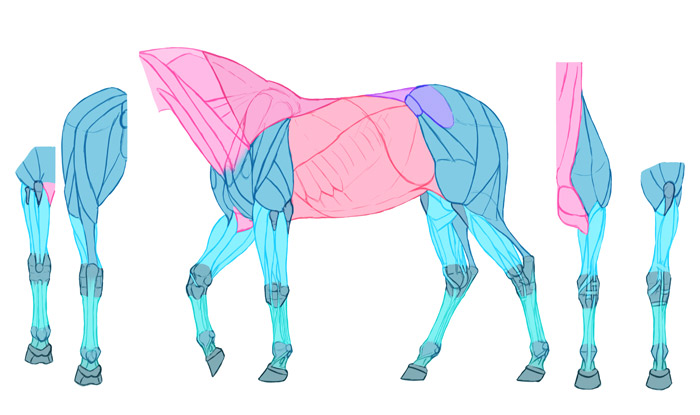

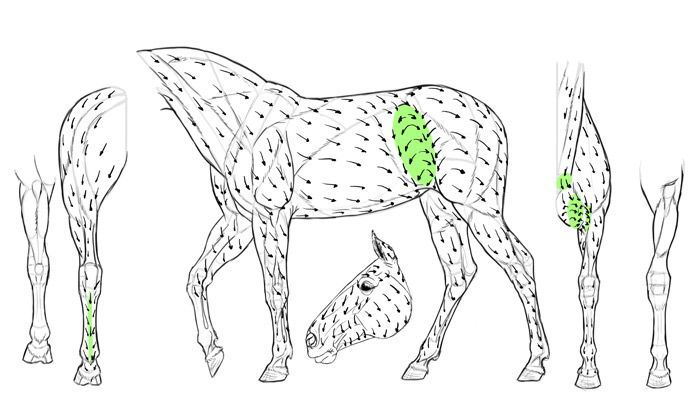

0 Response to "How To Draw A Horse Hoof"
Post a Comment